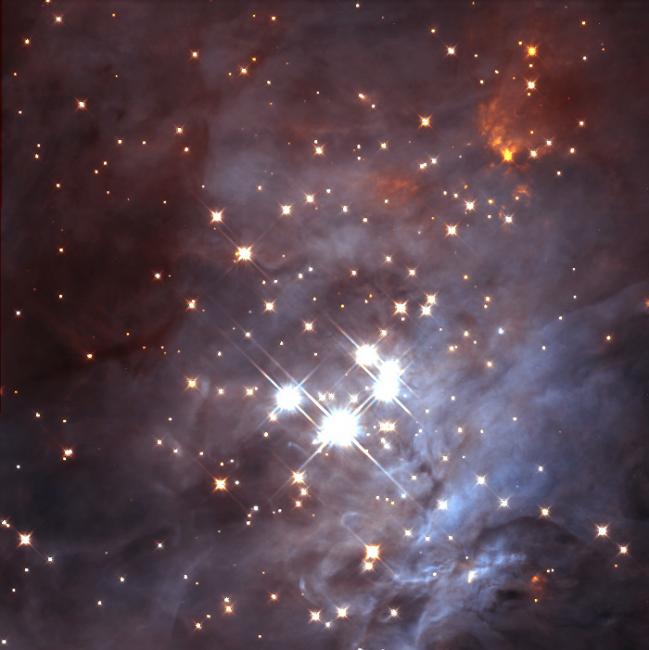
An image of the Trapezium Cluster in the Orion Nebula as seen by Hubble. Invisible to Hubble is "Source I", the most luminous young star in the cloud, and which is deeply embedded in dust seen below the red glow in the top right corner. (Credit: NASA/HST)
The famous Orion Nebula is the closest nursery of massive young stars to the earth, and is about 1300 light-years away. The nebula is part of a giant molecular cloud that hosts several clusters of hot young stars, with the brightest young star in the nebula, called Source I, shining with the luminosity of 100,000 suns. Determining how stars form is essential to understanding the origins and evolution of our solar system, as well as the galactic environment, and so it has been something of a challenge to astronomers that the nature of Source I, the brightest young star in the nearest massive nursery, is a mystery.
One reason for this ignorance is that Source I is not seen at either visible or infrared wavelengths: it is so obscured by dust that it has been detected only at radio wavelengths so far. It also is surrounded by crowds of other, albeit less luminous stars, confusing matters. Some evidence suggests that Source I is a single star driving outflowing jets of material, but other evidence argues for it being a group of stars. There are even data to suggest that it was ejected from another system just a few hundred years ago.
Source I is unique in one more way: it is one of only three star-forming regions known to have maser emission from the silicon monoxide (SiO) molecule. Masers are the radio analogs of lasers, and these bright beams of SiO emission arise from knots of very dense gas that are most often found associated with old stars. SAO astronomers Lynn Matthews, Lincoln Greenhill, Ciriaco Goddi, and Liz Humphreys, together with two colleagues, have used radio astronomy techniques of very fine spatial mapping to make a movie of the SiO maser emission from Source I. They imaged the region down to a resolution of only 0.2 astronomical units (half the distance of Mercury from the sun in our solar system), and did so in nineteen "frames" over twenty-one months.
The movies, which are posted with their paper in the on-line journal, track the motions of over 1000 individual maser spots. The results, the most detailed view ever obtained of the dynamics and temporal evolution of molecular material near a massive young star, show when analyzed that Source I has a mass of about eight solar-masses, and is near the center of an X-shaped outflow that is very likely the result of a bipolar wind emanating from a rotating disk seen edge-on. The paper, besides helping to resolve many of the outstanding puzzles about Source I, also provides compelling evidence that both accretion onto a disk and low-velocity winds are key elements in the evolution of young stars of this mass.